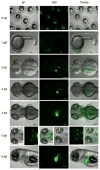Estrogen receptor signaling during vertebrate development
- PMID: 24954179
- PMCID: PMC4269570
- DOI: 10.1016/j.bbagrm.2014.06.005
Estrogen receptor signaling during vertebrate development
Abstract
Estrogen receptors are expressed and their cognate ligands produced in all vertebrates, indicative of important and conserved functions. Through evolution estrogen has been involved in controlling reproduction, affecting both the development of reproductive organs and reproductive behavior. This review broadly describes the synthesis of estrogens and the expression patterns of aromatase and the estrogen receptors, in relation to estrogen functions in the developing fetus and child. We focus on the role of estrogens for the development of reproductive tissues, as well as non-reproductive effects on the developing brain. We collate data from human, rodent, bird and fish studies and highlight common and species-specific effects of estrogen signaling on fetal development. Morphological malformations originating from perturbed estrogen signaling in estrogen receptor and aromatase knockout mice are discussed, as well as the clinical manifestations of rare estrogen receptor alpha and aromatase gene mutations in humans. This article is part of a Special Issue entitled: Nuclear receptors in animal development.
Keywords: Aromatase; Estrogen; Estrogen receptor; Reproductive development; Sex differentiation; Vertebrate development.
Copyright © 2014 Elsevier B.V. All rights reserved.
Figures



References
-
- Aidoo-Gyamfi K, Cartledge T, Shah K, Ahmed S. Estrone sulfatase and its inhibitors. Anti-cancer agents in medicinal chemistry. 2009;9:599–612. - PubMed
-
- Al Sweidi S, Sanchez MG, Bourque M, Morissette M, Dluzen D, Di Paolo T. Oestrogen receptors and signalling pathways: implications for neuroprotective effects of sex steroids in Parkinson’s disease. Journal of neuroendocrinology. 2012;24:48–61. - PubMed
-
- Aquila S, Sisci D, Gentile M, Middea E, Siciliano L, Ando S. Human ejaculated spermatozoa contain active P450 aromatase. The Journal of clinical endocrinology and metabolism. 2002;87:3385–3390. - PubMed
Publication types
MeSH terms
Substances
Grants and funding
LinkOut - more resources
Full Text Sources
Other Literature Sources

